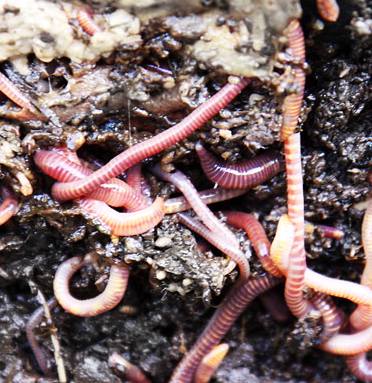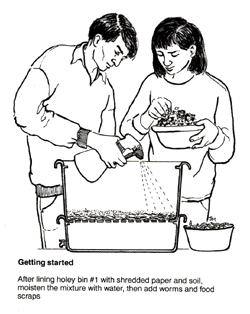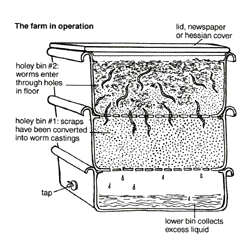Worm Farming - A Guide
on How to Set Up for Worm Composting in 4 Months
Vermiculture, therefore is just a fancy word for worm farming.
There are so many benefits to keeping earthworms, however you need to make sure that you get the right species to do the job.
5 Benefits of Worm Farming
Earthworms in general, are definitely a gardener's friend. They benefit the soil in so many ways.Firstly, they help build good soil through their tunneling actions, aerating the soil as they go. However, it is not just the aeration, they leave behind higher concentrations of nitrogen, calcium, magnesium, and phosphates in the soil.
Secondly, while they are burrowing around, they are eating and processing the soil leaving behind these deposits of rich worm castings, that improve the soil in such a way that it maintains moisture for longer.
Thirdly, they are generated an endless supply of cheap compost that is chemically-free, eco friendly and uses up biodegradable matter that before you would have just thrown away.
Fourthly, by using worm compost it suppresses certain types of weeds that would grow if the compost were not present.
Fifthly, the worm compost also promotes better root growth and structure, and is an excellent medium for growing seedlings and seeds as it enhances germination and crop yields.
Finally, the castings are actually just deposits of processed soil that has passed through the gut and out the other end. This is enriched humus that has an almost zero pH level, and it is this that is the pefect food for your vegetables and plants.
So, if you have always wanted to keep earthworms and have a go at worm farming, but didn't know where to start, this guide is for you. I will show you how easy it is, and how you can have this friable vermicompost within 4 short months that will help to grow vegetables and improve the soil to the rest of your garden.
Vermicompost really is vital to good soil. In the previous article on Organic Farming one of the sections dealt with soil and how important having healthy soil is to Organic Farming as a healthy soil equates to healthy vegetables and cattle. One of the main contributors to this process is the lowly earthworm through worm farming.
However, more and more people nowadays are realizing how useful this little animal is.
How to Set up a Simple Worm Farm
How Many Worms do you Need to Start a Worm Farm?
But there are some considerations to take into account, such as
- how much household garbage do you have that you could feed your worms on a daily basis?
- Do you have a ready access to other forms of food for them if needs be?
Which Earthworms make Good Compost in Worm Farming?

1) The Garden Worm
2) The Native Nightcrawler
3) The African Nightcrawler
4) The Red Worm
The garden worm is the large worm that you will see in your own gardens, especially after the rains have visited. They have a small section of their body that seems to have a wider band. Although they may be plentiful in your garden these are not good worms for your composting venture.
The native nightcrawler is another earthworm variety that is no good for your farms because it is a slow breeder and doesn't like his habitat disturbed so a rather fussy worm that is best left alone.
The African nightcrawler is a close relative and again is a slow breeder and not worth keeping.
The red worms are those that are well sought after by fishermen and worm farmers alike, therefore also known as the manure worm. Although there are two types of red worms, the Lumbricus Rubellis is the worm you want. It is able to consume large amounts of household garbage, reproduces quickly and doesn't mind having his habitat disturbed from time to time when you want to harvest the castings.
Although they are not very large in size, adults only reaching 3 inches on average, which is different to some of the other worms, like the African nightcrawler whose average length is 5 inches, although can reach up to a foot in length, these little manure worms reproduce every 7 days.
Some of the slower breeds of earthworms only reproduce once every 2 years. The red worm is mature at 9 months but can start mating as early as 2 months old and has a lifespan of 15 years.
So you can see, that the red worm is definitely the species to buy when setting up your new worm farms. Not only will this be a good choice for your garden, but these wrigglers are very popular with fishermen too, which is another sideline that you can venture into in order to maximize profits.
Fishermen like them because they do not drown while in the water, continue to wriggle to attract the fish whilst on the hooks and don't loose their color either. However, with millions of wrigglers being sold each week around the country, you will need to have a fairly large population of worms first before you decide to set yourself up as a supplier of bait to fishermen. Bags of worms are packaged from the 100s to the 1000s depending on the type of demand.
How Much Space do Earthworms Need for Worm Farming?
As a benchmark for 2-3 people you should have composting bins measuring 60 x 60 x 30 cm stocked with 1 kg of worms.
What Containers to Use for Worm Farming
Worm bins can be either:
- Plastic
- Wood
- Metal
How deep should a worm box be?
You have to look at the nature of these worms. They will live towards the top half of the soil, therefore anything deeper than 12 inches will not only be wasteful, but it can also cause your bins to smell due to too much material and micro-organisms that will flourish in deep material where there is no light and little oxygen.Most small composting bins for vermicompost use can be grouped into three categories:
1) Non-continuous composting bin
This is an undivided container, a layer of organic matter is placed in the composting bin lining the bottom. Worms are then added and organic matter for composting is added in a layer above the bedding. Another layer is added on top of the organic matter and the worms will start to compost the organic matter and bedding. This type of bin is often used because it is small and easy to build. But it is relatively difficult to harvest because all the materials and worms must be emptied out when harvesting.
2) Continuous vertical flow composting bin
This is a series of trays are stacked vertically on top of one another. The bottom tray is filled first, in a similar fashion to the non-continuous bin, but is not harvested when it is full. Instead, a thick layer of bedding is added on top and the tray above is used for adding organic material.
Worms finish composting the materials in the bottom tray and then migrate to the one above. When a sufficient number of worms have migrated, the worm compost in the bottom tray can be collected and should be relatively free of worms. These bins provide an easier method of harvesting, as they do not all have to be emptied out.
3) Continuous horizontal flow composting bin
This is a series of trays are lined horizontally. This method too relies on the earthworms migrating towards a food source in order to ease the process of harvesting. The composting bin is usually constructed to be similar to a non-continuous bin but is longer and lies horizontally. It is divided in half, usually by a large gage screen of chicken wire.
One half is used until it becomes full, then the other half is filled with bedding and organic matter. In time, the worms migrate to the side with the food and the compost can then be collected. These bins are larger than a non-continuous system but still small enough to be used for small-scale worm farming, with the added advantage of being easier to harvest.
Placing your Worm Farm Bins
Rather place the bin in a sheltered area out of the sun. In winter, you could move the bin to the garage, or surround it with some form of shelter like hay bales to keep the snow, rain and cold out.
Setting up the composting bin is easier than you may think. All you need to start your worm farm are the following:
* A plastic bin with a lid to keep away the flies and to cut down on odors while the matter is decomposing. However, your worms will need oxygen, so drill holes in the bottom of the bin for ventilation and drainage and further help this process by placing the bin on some bricks to elevate it off the ground.
* Place some bedding in the bin for the worms in the form of either shredded paper (that from a mechanical shredder is perfect as it is really fine), peat moss or shredded coconut hair (coir) that can be commercially bought. Do not use glossy paper or magazines. This should not be more than about a fifth of your bin space. Remember that the worms eat the bedding, so you need to replenish this every few months.
* Water to dampen the bedding. Make sure that you don’t flood the composting bin with too much water. You just want to make the bedding moist.
* Now place your worms into the bin. Make sure that you do this on a sunny day and that the sun is shining into the compost bin.
* Earthworms don’t like the sun and they will immediately start digging down into their new home. If you don’t have the sun shining for this exercise you may find that most of your worms have crawled out of the bin and left for greener pastures! The worms can be bought commercially, including over the Internet.
* Now cover with two handfuls of soil to the bedding in each bin to supply "roughage" for the worms. Adding crushed eggshells provides not only roughage but also calcium for the worms, and it lowers acidity in the bin. Powdered limestone will also reduce the soil acidity, but don't use slaked or hydrated lime as this will kill your worms. Now put the lid down on the bin.
Feeding your Worms
There are two methods of adding food scraps to the bin when worm farming.* Pocket feeding — a top layer of bedding is maintained and food is buried beneath by drilling down into the bedding. The location of the food is changed each time, rotating around the bin to give the worms time to decompose the food in the previously fed pockets. The top layer of bedding is replaced when necessary.
One pound of worms will eat about three and one half pounds of food scraps a week. If you add more food than your worms can handle, anaerobic conditions will set in and cause the soil to sour. Make sure that food scraps are always buried under the soil to avoid attracting flies and rodents.
What do Earthworms Eat and How much do I Feed them?
If you are giving them waste from your kitchens that is high in water then they will go through watermelon, for example a lot quicker than they will go through uncooked pumpkin. However, if you were to process that same waste and put it through a food processor or blender, then your worms could process that far more quickly and then could eat 3-4 times their body weight in one day.
However, as a rule of thumb earthworms eat 1/3rd to 1/2 of their bodyweight in food, per day. Therefore 2 lbs of earthworms which amounts to about 4000 worms could eat their way through 1lb food per day. The bigger your household, the more garbage you will generate and therefore the bigger your worm farm could be.
 *
Get your food scraps that
you
have
been saving up. The best scraps are fruit and vegetable
peelings, fruit
skins, apple cores etc. If you want to help your worms along, some of
those scraps could be liquidized in a blender to quicken the process.
*
Get your food scraps that
you
have
been saving up. The best scraps are fruit and vegetable
peelings, fruit
skins, apple cores etc. If you want to help your worms along, some of
those scraps could be liquidized in a blender to quicken the process.
Additions such as cow, sheep, pig or chicken manure is a bonus, but it is not a necessity. If you keep rabbits then you should think of keeping earthworms as rabbit manure is perfect for them as long as you meet two conditions;
1) Don't feed manure to the worms if the animals from which the manure comes have been dewormed, as this will kill your worms.
* Coffee grounds, tea leaves and coffee filters can all be fed to your worms.
* Meat is important to your worms as they are a good source of nitrogen. However, the problem with adding meat to your bins is that it will quickly spoil and smell. In order to minimize the smell, chop the meat scraps up small, and mix them with sawdust before adding to the bins.
* Chicken mash should be fed to your worms to give them a boost for both propagation and fattening up if you are wanting to sell them off to fishermen. Just sprinkle some chicken mash on top of the beds. You will soon know just how much your worms will take down however, don't overfeed as the soil can turn soil very quickly.
| Studies have shown that there is a correlation between food types and rates of breeding. Food that is high in nitrogen results in faster breeding. However, remember that the carbon:nitrogen ratio of foodstuffs in your bins should be about 20:1 respectively. |
What not to Feed Earthworms
- In setting up your worm farm avoid feeding the worms the following: Rotten foods, fats or dairy products, citrus, onions and garlic, fish, bones, tobacco, or pet or human manure.
- Too much fat prevents the earthworms from breathing properly as they breathe through their skin.
- Also avoid using too many watermelon skins as they really don’t have a lot of nutritional value for the earthworm and they also disrupt the moisture levels of the compost.
- If your lawns have been sprayed with any weed killer avoid feeding these clippings to the worms.
Maintaining and Caring for your Worms
Feeding them just once or twice a week is enough, as long as you remember that the longer you have your worms the more you will have, under the right conditions, and so you need to increase the amount of food that you give them accordingly. However, never overfeed.
When worm farming make sure that you have enough moisture in your bin, without it getting too wet. This is because the earthworm breathes through its skin as previously mentioned, and they need moisture to survive. However, if the soil is too wet then you end up with carbon dioxide in the soil instead, which will poison them.
Also, make sure that the compost is alkaline rather than acidic. Your worms will be healthy when pH of the soil is between 6.8 and 7.2. This ideal pH level will allow your worms to successfully digest their food.
You should turn the bin contents over to aerate the soil. Scarify the top 3-4 inches only and do this about every 3 weeks.
To keep the moisture in and to keep the light out, a good way of doing this is by using a damp piece of burlap and placing it on top of the worm bins, or containers. Carpet underlay can also be used. Not only are you keeping the light out, but you are also helping to insulate the soil and protect it against extreme temperatures.
Finally, your earthworms need warm soil. 16º-25º C
So, in Summary Your Earthworms Require 6 Things to Exist:
i) Oxygen
ii) Moisture
iii) Food Scraps
iv) Optimal soil pH
v) A dark place to live
vi) Warmth
If all requirements are met your worms will live quite happily in their new environment and will also procreate. Adult worms produce three cocoons a week and each cocoon will contain at least three baby worms and sometimes ten or more. Every three months the worms should be harvested or separated from the castings.
Make sure that your soil never smells sour. If this happens it means that the soil is too wet. If it smells sour then add calcium carbonate, also known as garden lime – very different to ordinary lime which will kill your worms, crushed egg shells, dirt, sand, or more newspaper to soak up that excess moisture.
So how wet should your compost be when worm farming? - About 75% moist. What exactly does this mean? I can already hear you ask. Well, if you take a handful of matter and squeeze it hard you should only get about a drop or two of liquid. This is just how your worms like their environment and will be quite happy to stay.
No only will they be happy to stay they
will also multiply. If conditions are good, you will double your worm
population in six months. If the worms become crowded and you do not
remove any, then worms will slow down their reproduction.
Knowing When and How to Harvest the Vermicompost for your Worm Farm
 After
about six weeks, you will begin
to see worm castings (soil-like material that has moved through the
worms' digestive tracts).
After
about six weeks, you will begin
to see worm castings (soil-like material that has moved through the
worms' digestive tracts).
Castings can boost plant growth, since they are rich in organic matter and the nutrients plants need to thrive, and are pulsing with biological activity that will bring life to your soil eco-system.
After about 4 months it will be time to separate the worms from the compost. If you have a non-continuous or undivided container, it is more difficult to harvest the worms. However, this situation is certainly not impossible.
Take the contents and turn it upside-down on a piece of plastic such as a ground sheet or a tarpaulin. Because the earthworms are photosensitive, if this is done on a sunny day the worms will start burrowing down, and then it is easy to start scraping the compost from the top, waiting in between for them the move downwards. Wait 20-30 minutes before starting to scrape off the top layer of compost.
If, however, you are the impatient type, get yourself a fine meshed sieve, the type they use in construction yards, if your compost heap is fairly large, or a large household sieve will do. Sieve the compost until you have finely granulated composted on one side, and your worms in the other to start the process all over again.
Don’t be lazy and put the worms into your soil along with the compost. It’s not that the worms will damage your plants in any way, but red worms are not worms that will survive for any length of time in such soil. In nature, this type of worm lives in mild climates in the leaves on the forest floor or in manure piles.
Be on the lookout for worm eggs. They are lemon-shaped and about the size of a match head. They are shiny in appearance, and are light brown in color. The eggs contain between two and twenty baby worms. Although it is time consuming, you may want to return the eggs to your bin so they can hatch and thrive.
Another way to harvest the compost during worm farming is to move the compost to one side of the box and add fresh bedding and food to the other side. Then only bury food on the new side. In six weeks, the worms will have migrated to the new bedding and you can harvest the finished compost, and replace it with new bedding.
Worm Farming and How to use the Worm Casts
- You can use your vermicompost straight away or store it and use it later. It will be good for about a year. Mix it into the top six inches of soil in your garden and around your trees and plants. You can also use it as a top dressing on outdoor plants or sprinkle it on your lawn like you would as if you were top-dressing. Vermicompost makes great nutrient-rich mulch so is perfect for areas that don’t get lots of rain for moisture retention.
- For indoor plants, you can safely mix vermicompost with your potting soil. You can place the castings 1/4 inch down into the soil, and repeat every 2 months. Unfortunately, worm castings can contain quite a bit of salt which is not a problem when you add them to your garden, but when you add them to container plants make sure that you water your plants well to wash away any excess salt that might build up in the soil. Just make sure that you have removed all worms and eggs from the compost as they will not survive in an indoor pot.
- If you are planting new shrubs, roses, or fruit trees in your gardens you can add a couple of handfuls of worm castings to the bottom of your holes before planting.
- You can also make a "compost tea" or liquid fertilizer to feed to your plants with worm farming. An easy recipe is to add two tablespoons of worm compost to one quart of water and allow it to steep for a day, mixing occasionally. Water your plants with this "tea" to give them a boost.
Of course you can make compost without worms too as long as you have some rotting material and lots of bacteria bugs. But do you know the optimal carbon to nitrogen ratio for this? Visit our Simple Life to find out more about the ratio and find other interesting worm composting links on the site, or just read about their very interesting site on how they changed their lifestyles.
Common Pests and Problems with Worm Farming
Unfortunately, when you have food about you will attract insects that you don't want. The following are possible pests:- Ants: use an organic pesticide to get rid of the ants as you don't want them anywhere near your worms
- Rats: partly compost any food in covered bins first, before adding them to the compost bins/beds
- Earwigs: scrunch up wet newspaper and use these as traps. Burn them the next day.
- Snakes: be wary of snakes who like the moist soil and will drastically reduce your worm population
- Foxes: make your property as fox-proof as possible, adding sensor security lights, where you can and putting human hair in stockings and tying them around the bins or beds
- The worms themselves are free of diseases, but if there is an acid build up in the soil, then they can die from a build up of gas from food they have ingested, resulting in their crops exploding.
- Some people have also experienced problems with mites, nematodes, and parasite protozoa.
- Keep your beds free from weeds and tree roots that will rob the soil of good nutrients. Line your beds with polythene sheeting to prevent this from happening.
- If
conditions are not right, your worms will pack up and move elsewhere!
Wind, rain, temperature changes, lack of food, lack of moisture can all
result in your worms migrating to greener pastures. Install overhead lighting to prevent this, and keep conditions as optimal as possible.
RECOMMENDED BOOKS ON WORM FARMING
Looking for more Information on Worm composting and Worm Farming?
For more information on how, as a dairy farmer, you could make good use of all that cow manure. Have a look at this fascinating video on commercial worm farming.
The Worm Power Story
Did you find this page helpful?
Sharing is a way of saying, "Thanks!"










New! Comments
Do you have something of value to add? Leave me a comment in the box below.